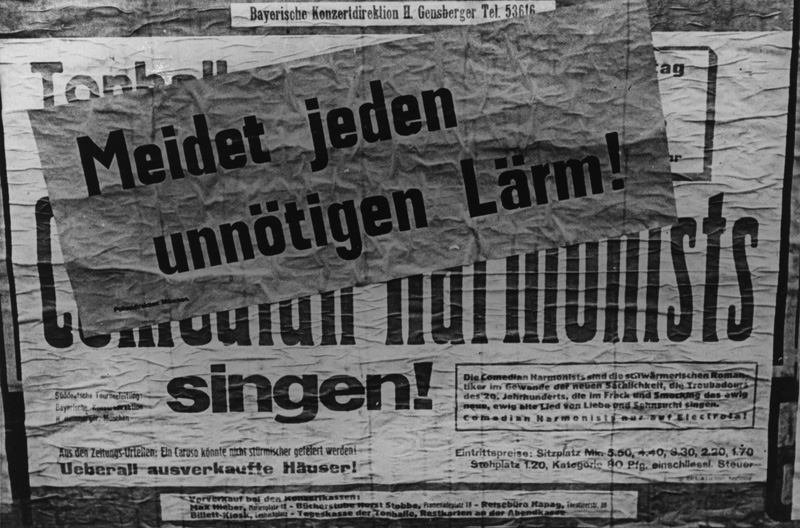Quellen
Haerendel,
Ulrike:
Tonhalle,
in: Nerdinger, Winfried (Hg.): Ort und Erinnerung.
Nationalsozialismus in München, München 2006, S. 209.
Meyer,
Gabriele (Hg.): 100 Jahre Münchner Philharmoniker, München 1994.
Admission free
Konzertgebäude für die Münchner Philharmoniker

Boykottaufruf der Münchner Polizeidirektion gegen ein Konzert der Comedian Harmonists in der Tonhalle am 13.3.1934 | Stadtarchiv München, NS-00121
Im Jahr 1893 gründete Franz Kaim, Sohn eines Klavierfabrikanten, zusammen mit dem Philharmonischen Chor München das sog. „Kaim-Orchester“. Zwei Jahre später bezog es ein von Martin Dülfer erbautes Gebäude an der Türkenstrasse 5, das 1905 in Tonhalle umbenannt wurde. 1908 entstand der Konzertverein, der als Namensgeber und rechtlicher Träger fungierte, auch nachdem 1924 die Stadt München die finanzielle Verantwortung für das Orchester übernommen hatte, das seit 1928 „Münchner Philharmoniker“ heißt. Als zentraler Bestandteil des Münchner Musiklebens realisierte das Orchester in seiner Zusammenarbeit mit berühmten Dirigenten und Komponisten wie etwa Gustav Mahler, Hans Pfitzner und Richard Strauss etliche Uraufführungen.
In der auch für allgemeine Veranstaltungen genutzten Tonhalle hielt Thomas Mann am 30.11.1926 im Rahmen der Kundgebung „Kampf um München als Kulturzentrum“ eine bedeutende Rede. Er erinnerte an München als Zentrum der künstlerischen Avantgarde während der Prinzregentenzeit und geißelte den kulturellen Niedergang der bayerischen Landeshauptstadt und ihre Verwandlung in einen Hort der Reaktion während weniger Jahre.
Nach 1933 wurden die Münchner Philharmoniker, die die Tonhalle als Heimstatt hauptsächlich nutzten, zu einem wichtigen kulturellen Botschafter der „Hauptstadt der Bewegung“ mit hohem, überregionalen Renommee. Sie feierten unter dem Chefdirigenten Oswald Kabasta ab 1938 große Erfolge auf Tourneen im benachbarten Ausland. Dabei bestand das Repertoire vorwiegend aus Werken der klassischen und romantischen „deutschen“ Musikliteratur von Beethoven bis Bruckner.
Am 25. April 1944 wurde die Tonhalle durch Bombenangriffe schwer beschädigt. Das Orchester, das erst 1943 vollständig als städtische Einrichtung übernommen worden war, wurde zum 1.9.1944 offiziell aufgelöst. Das erste Konzert der Münchner Philharmoniker nach dem Zweiten Weltkrieg fand am 8.7.1945 unter der Leitung von Eugen Jochum statt.
Ab 1953 konzertierte das Orchester, da die Tonhalle nicht wieder aufgebaut wurde, in dem nach dem Krieg erbauten Herkulessaal der Münchner Residenz. Seit der Eröffnung des Gasteig im Jahr 1985 hat das Orchester mit der Philharmonie im Gasteig wieder einen eigenen Konzertsaal. Heute befindet sich an der Türkenstrasse 5 ein Bürohaus.
Haerendel,
Ulrike:
Tonhalle,
in: Nerdinger, Winfried (Hg.): Ort und Erinnerung.
Nationalsozialismus in München, München 2006, S. 209.
Meyer,
Gabriele (Hg.): 100 Jahre Münchner Philharmoniker, München 1994.